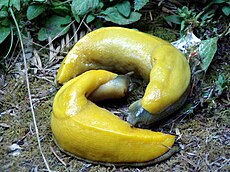Banana slug
| Banana slug | |
|---|---|
 |
|
| Two banana slugs preparing to mate | |
| Scientific classification | |
| Kingdom: | Animalia |
| Phylum: | Mollusca |
| Class: | Gastropoda |
| (unranked): |
clade Heterobranchia clade Euthyneura |
| Superfamily: | Arionoidea |
| Family: | Ariolimacidae |
| Subfamily: | Ariolimacinae |
| Genus: |
Ariolimax Mörch, 1859 |
| Species | |
|
Ariolimax californicus |
|
clade Euthyneura
clade Panpulmonata
clade Eupulmonata
clade Stylommatophora
informal group Sigmurethra
Ariolimax californicus
Ariolimax columbianus
Ariolimax dolichophallus
Banana slug is a common name for three North American species of terrestrial slug in the genus Ariolimax. These slugs are often yellow in color and are sometimes spotted with brown, like a ripe (or overripe) banana.
Species within the genus Ariolimax include:
Banana slugs are often bright yellow (giving rise to the banana sobriquet) although they may also be greenish, brown, tan, or white. The species Ariolimax columbianus sometimes has black spots that are so extensive that the animal looks almost entirely black. Individual slugs will change colors with alterations in food consumption, light exposure, and moisture levels. Color may also indicate whether a slug is healthy or injured or what age it is.
The Pacific banana slug is the second-largest species of terrestrial slug in the world, growing up to 25 centimetres (9.8 in) long, and weights of 115 grams (4.1 ounces). (The largest slug species is Limax cinereoniger of Europe, which can reach 30 centimetres (12 in) in length.) Banana slugs have an average lifespan of 1-7 years.
Banana slugs (like other gastropods and many other mollusks) have a radula, a ribbon-like anatomical structure covered in rows of microscopic teeth; the radula is used for feeding. Individuals can move at 6 1⁄2 inches (17 cm) per minute.
Slugs use two pairs of tentacles to sense their environment. The larger, upper pair, termed "eyestalks," are used to detect light or movement. The second, lower pair are used to detect chemicals. The tentacles can retract and extend themselves to avoid damage. If a predator bites off a tentacle, the slug can grow a new one.
...
Wikipedia
